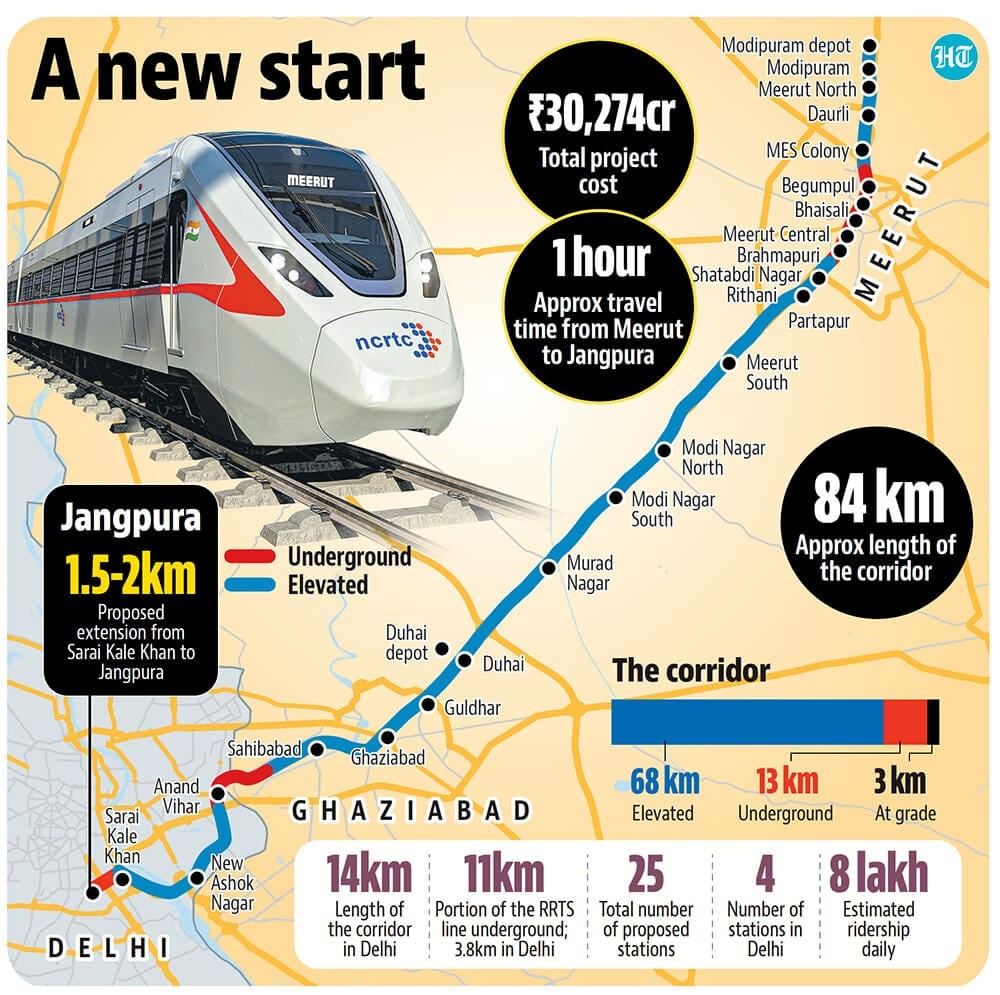Table of Contents
Context: Prime Minister Narendra Modi inaugurated the first phase of India’s first Regional Rapid Transit System (RRTS) project, running between Sahibabad and Duhai on 20th October 2023. The RRTS trains will be known as “Namo Bharat Train“, marking a new era of regional connectivity. The entire RRTS network is expected to be completed by 2025. Since its launch, the Namo Bharat train has been utilised by approximately 2,900 passengers daily.
What is RRTS?
Regional Rapid Transit System (RRTS) is a new, dedicated, high-speed, high-capacity, comfortable commuter service that connects regional nodes in the National Capital Region (NCR). It is different from both the metro and conventional railways in several ways:
- RRTS is designed for longer trips with fewer stops and higher speeds than the metro.
- RRTS is more reliable and high-frequency than conventional railways, and it provides point-to-point travel along a dedicated path.
Background
In 2005, the Planning Commission formed a Task Force led by the Secretary of the Ministry of Urban Development (MoUD) to develop a multi-modal transit system for the Delhi National Capital Region (NCR). This was included in the Integrated Transport Plan for NCR 2032, with a special emphasis on the Regional Rapid Transit System (RRTS) connecting regional centres.
The Task Force identified 8 corridors and prioritized three corridors for implementation: Delhi-Meerut, Delhi-Panipat, and Delhi-Alwar. In March 2010, the National Capital Region Planning Board (NCRPB) appointed M/s. Delhi Integrated Multi-Modal Transit System and M/s. Urban Mass Transit Company Limited to conduct feasibility studies and prepare Detailed Project Reports for the Delhi-Meerut and Delhi-Panipat corridors, respectively.
We’re now on WhatsApp. Click to Join
Latest Stats of Namo Bharat Train-RRTS
- The Ghaziabad Regional Rapid Transit system’s train service, which connects to areas such as Sahibabad, Ghaziabad, Guldhar, Duhai, and Duhai Depot, has seen over 7,29,574 passengers in total. Five stations on this route are currently operational.
- Financially, the project has accrued an income of Rs. 2.75 lakhs by December 2023 and Rs. 3.79 lakhs in January 2024.
- These figures reflect the growing patronage and potential revenue-generation capacity of the transit system.

Namo Bharat Train Features
The Namo Bharat Train is a major investment in the future of transportation in India. It is expected to improve connectivity, reduce traffic congestion, and create jobs in the region. Here are some of the key features of the Namo Bharat Train:
- Designed for speeds of up to 160 km/h
- Operates on a dedicated track
- High frequency of 5 to 10 minutes
- Equipped with modern amenities and features
Namo Bharat Train Benefits
he Namo Bharat Train will offer a number of benefits, including:
- Reduced travel times: The Namo Bharat Train will operate at speeds of up to 160 km/h, which will significantly reduce travel times between different cities in the NCR.
- Increased frequency: The Namo Bharat Train will operate at a high frequency of 5 to 10 minutes, which will make it easier for commuters to travel at their convenience.
- Improved reliability: The Namo Bharat Train will operate on a dedicated track, which will make it more reliable than other modes of transportation.
- Enhanced comfort: The Namo Bharat Train will be equipped with modern amenities and features to ensure a comfortable journey for passengers.
Corridors Being Developed under RRTS Phase I
1. Delhi – Ghaziabad – Meerut Corridor
2. Delhi – Gurugram – SNB – Alwar Corridor
3. Delhi – Panipat Corridor

The RRTS network will provide world-class, safe, and fast (160 km/h) commuter transit services with high frequency (5 to 10 minutes). For non-stop journeys, the technology used will allow distances of 100 km to be covered in under 45–50 minutes. The project will also ensure convenient and high-quality last-mile connectivity to meet the needs of all travellers on the network. The network will be planned and spatially oriented to ensure seamless integration with the Indian Railways, Interstate Bus Terminals (ISBTs), Airports, and the Delhi Metro.
Delhi – Ghaziabad -Meerut
– Length = 82 kms
– Number of RRTS Stations =16
– Number of additional Stations for Meerut MRTS = 9
Delhi – Gurugram – SNB- Alwar
-Length = 164 kms
-Number of Main Line Stations =22
Delhi – Panipat
-Length = 103 kms
-Number of Main Line Stations =16 (including Sarai kale khan)
Other Corridors under RRTS Phase II


 Pariksha pe Charcha 2025, Overview, Even...
Pariksha pe Charcha 2025, Overview, Even...
 Languages of the World List, Most Spoken...
Languages of the World List, Most Spoken...
 Vijay Hazare Trophy 2024, Schedule, Team...
Vijay Hazare Trophy 2024, Schedule, Team...




















